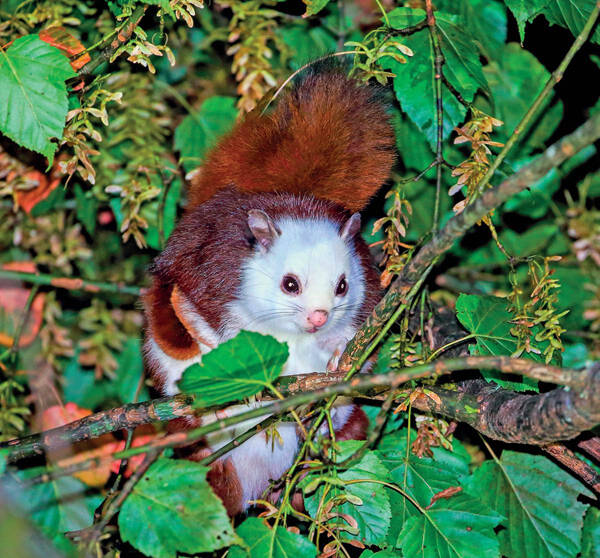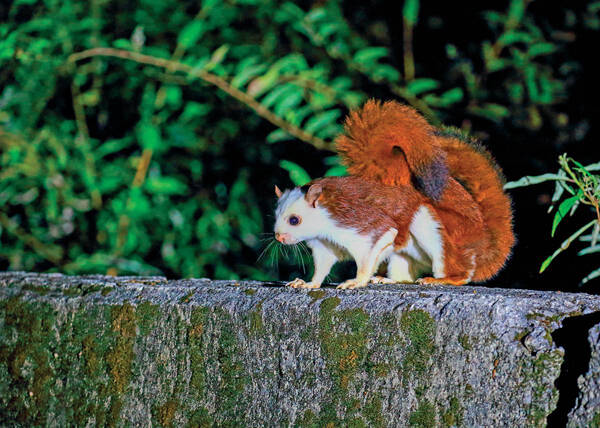Petaurista alborufus
IUCN
LCBasic Information
Scientific classification
- name:Petaurista alborufus
- Scientific Name:Petaurista alborufus,Red-and-white Giant,Flying fox, pine cat, white-faced flying squirrel, white-headed flying squirrel, white-fronted flying squirrel
- Outline:Rodents
- Family:Rodentia Sciuridae F.Squirrel
Vital signs
- length:35-60cm
- Weight:2000g
- lifetime:7-10years
Feature
It has a short and round head, large eyes, chestnut eye rims, particularly large pupils, red and white fur, and a tail that is almost as long as the body.
Distribution and Habitat
In China, it is distributed in Yunnan, Guangxi, Guizhou, Chongqing, Sichuan, Gansu, Shaanxi, Hunan, Hubei, Jiangxi and Taiwan. Abroad, it is mainly distributed in Myanmar.
It usually lives in subtropical evergreen broad-leaved forests, mixed coniferous and broad-leaved forests and dark coniferous forests at an altitude of about 1000-3000m.
Appearance
A large flying squirrel. Compared to other species of flying squirrels, the fur of the red-and-white flying squirrel is denser and more lustrous. The head is white, the eye sockets are reddish brown, the back, sides and wing membranes are mostly chestnut brown or reddish brown, and the abdomen is orange-red (there are also individuals with grayish white in the central area). The typical external features of the red-and-white flying squirrel are: a large light yellow or yellow-white patch in the center of the waist.
Details
Red and white flying squirrels are large flying squirrels with a body shape very similar to that of squirrels. They live in forest areas on hillsides or in limestone shelters at an altitude of about 1,000 meters, mainly in dense forests of tall trees such as poplars, walnuts, and birches.

During the day, red and white flying squirrels often curl up in tree holes or burrows, sleeping with their heads resting on their tails. At night, they come out to move around and forage. They live alone, feeding on fruits, seeds, buds, leaves and insects of trees. Each time they go out, they can go as far as 1 km away. The red-and-white flying squirrel also has a strange characteristic: no matter how far away from the cave, it always returns to the cave nest before excreting feces.
In winter, the red-and-white flying squirrel lives in tree holes or rock caves, no longer goes out to forage, and enters hibernation until the climate warms up, then it resumes activities.
The red-and-white flying squirrel glides while screaming from time to time. "Squeak", "squeak, squeak", "squeak, squeak, squeak", the sounds are long and short, this is the "language" that red and white flying squirrels use to convey information to each other. "Squeak" means "all is well" and normal activities can be carried out; "squeak, squeak" means chasing or escaping each other; "squeak, squeak, squeak" means emergency signals when threatened. When the "Ziwu" and "Wu, Wu" sounds are made, it is the time when the red and white flying squirrels are fighting against enemies with their teeth and claws. In early spring, red and white flying squirrels will make a "de-de-deyi" sound, which is a signal for male red and white flying squirrels to mate.

Its life span is generally 7-10 years, and its breeding period is about 7-8 years. The mating period of flying squirrels is from February to April every year. Female flying squirrels make melodious and pleasant courtship calls during estrus, and male mice will come to them as soon as they hear the calls, and mating is achieved quickly. The gestation period of female mice is 75 days, and they give birth to one litter each year, with 1-3 babies per litter, and a few give birth to more than 5 babies. After the baby flying squirrel is born, it opens its eyes in one month, grows full fur in 45 days, and generally feeds itself and turns to independent living after 3 months.
The red-and-white flying squirrel is a wild animal with beneficial or important economic and scientific research value under the protection of the Chinese state. The species has a wide distribution range and is not close to the vulnerable and endangered critical value standard for species survival (distribution area or fluctuation range is less than 20,000 square kilometers, habitat quality, population size, and distribution area fragmentation). The population trend is stable, so it is evaluated as a species without survival crisis.









